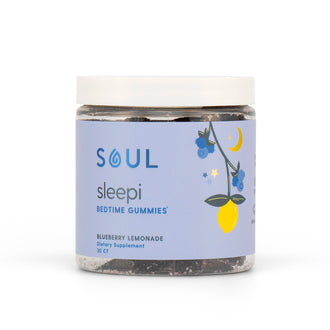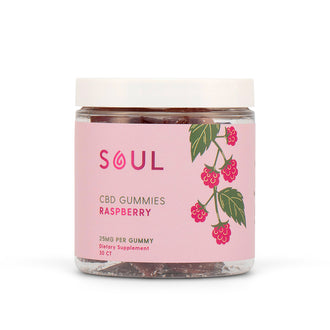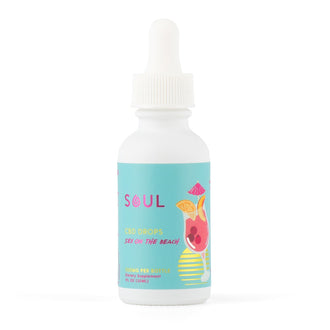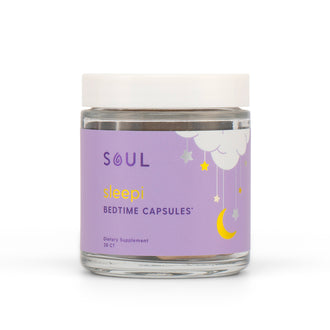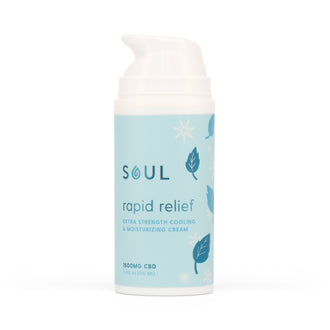
Key Takeaways:
- Significance of THC Potency: Learn the significance of THC potency and how it affects your cannabis experience.
- Using a THC Dosage Chart: Discover how to use a THC dosage chart effectively for different product types and user levels.
- Safe THC Consumption Practices: Gain insights into safe THC consumption practices to ensure a positive and controlled experience.
At Soul, we pride ourselves on creating high-quality, effective wellness products that cater to your individual needs. As a leader in the cannabis industry, we understand the importance of proper THC dosage for ensuring a safe and enjoyable experience.
THC, or tetrahydrocannabinol, is the main psychoactive compound in cannabis, and its effects can vary widely based on dosage, product type, and individual factors. Knowing how to correctly dose THC is crucial, especially with the growing variety of cannabis products available today.
In this piece, we will be discussing the importance of understanding THC dosage, how to use a dosage chart, and tips for safe consumption.
Understanding THC Potency
Cannabis enthusiasts and medical users alike often focus on the potency of THC (tetrahydrocannabinol) when selecting products. THC potency is a critical factor in determining the effects and therapeutic benefits of cannabis. It refers to the strength or concentration of THC in a cannabis product, which can vary widely depending on the form of consumption, such as flower, edibles, tinctures, and concentrates. This article explores the nuances of THC potency, why it matters, and how to understand the different levels found in various cannabis products.
What Is THC Potency?
THC potency measures the concentration of tetrahydrocannabinol, the primary psychoactive compound in cannabis. It is expressed as a percentage in products like cannabis flower or as milligrams in edibles. Higher potency typically means stronger effects, but it’s essential to consider individual tolerance and experience.
Factors Influencing THC Potency
Several factors can influence the potency of THC in cannabis products. These include the strain of the plant, growing conditions, and the method of consumption. For instance, indoor-grown cannabis under controlled conditions often has higher THC levels compared to outdoor-grown plants. Additionally, concentrates and extracts are designed to have high potency levels.
THC Potency In Cannabis Flower
Cannabis flower, or bud, is one of the most commonly used forms of cannabis. Its THC potency can range from 10% to 30%. Lower potency flowers are typically preferred by beginners or those seeking mild effects, while higher potency flowers are favored by experienced users looking for a more intense experience.
THC Potency In Edibles
Edibles are a popular choice for those who prefer not to smoke or vaporize cannabis. They provide precise dosages of THC, usually measured in milligrams. Common dosages range from 5 mg to 50 mg per serving. The effects of edibles can be more intense and longer-lasting than other forms, making it crucial to start with a low dose and increase gradually.
THC Potency In Tinctures And Oils
Tinctures and oils offer another method of consuming cannabis. They are typically taken sublingually (under the tongue) and can have varying THC potencies. These products often provide a rapid onset of effects and can be dosed precisely, making them suitable for both recreational and medicinal users.
THC Potency In Concentrates
Concentrates, such as shatter, wax, and hash, are known for their high THC potency, often exceeding 70%. These products are not recommended for beginners due to their intense effects. Experienced users may prefer concentrates for their potency and the ability to consume smaller amounts to achieve the desired effect.
Importance Of Understanding THC Potency
Understanding THC potency is crucial for determining the correct dosage and ensuring a safe and enjoyable experience. Knowing the potency helps users manage their intake, avoid overconsumption, and select products that meet their specific needs, whether for recreational enjoyment or medical relief.
The Importance Of A THC Dosage Chart
Navigating the world of cannabis can be challenging, especially when it comes to determining the right dosage. A THC dosage chart serves as a valuable guide for both novice and experienced users, helping them find the appropriate amount of THC to consume. By considering factors such as experience level, desired effects, and product type, a dosage chart can prevent overconsumption and enhance the overall cannabis experience. This article explores the significance of THC dosage charts and how they contribute to safer and more enjoyable cannabis use.
Benefits Of Using A THC Dosage Chart
A THC dosage chart provides a structured approach to cannabis consumption. It helps users identify the correct dosage based on their tolerance and desired effects. This reduces the risk of overconsumption and adverse reactions, promoting a safer and more controlled experience.
Tailoring Dosage To Experience Level
Different users have varying tolerance levels to THC. Novices typically require lower doses to achieve the desired effects, while experienced users might need higher doses. A dosage chart accommodates these differences, offering recommendations for beginners, intermediate users, and veterans.
Preventing Overconsumption And Adverse Effects
Overconsumption of THC can lead to unpleasant side effects such as anxiety, paranoia, and dizziness. A dosage chart helps users start with a safe, low dose and gradually increase it as needed. This approach minimizes the risk of negative experiences and ensures a smoother introduction to cannabis.
Adjusting For Different Product Types
THC dosage varies significantly across different cannabis products. Edibles, tinctures, and concentrates all have different potency levels and onset times. A dosage chart provides specific guidelines for each product type, ensuring users understand how much to consume regardless of the product they choose.
Managing Tolerance Levels
Regular cannabis use can lead to increased tolerance, requiring higher doses to achieve the same effects. A dosage chart can help users track their consumption and adjust their dosage over time. This allows for a balanced approach to cannabis use, avoiding unnecessary increases in dosage and maintaining effective results.
Enhancing Medical Cannabis Use
For medical cannabis patients, precise dosing is crucial for effective treatment. A THC dosage chart aids in determining the optimal dose to manage symptoms while minimizing side effects. It also assists healTHCare providers in making informed recommendations tailored to individual patient needs.
How To Use A THC Dosage Chart
Using a THC dosage chart is straightforward and can significantly enhance your cannabis experience. Here’s a step-by-step guide:
- Identify Your Experience Level: Determine if you are a beginner, intermediate, or advanced user. This will influence your starting dosage.
- Choose Your Product: Select the type of cannabis product you plan to use, such as edibles, tinctures, or flower. Each product type has different absorption rates and potency levels.
- Consult the Chart: Look up your recommended dosage on the chart based on your experience level and product type. The chart will typically provide a range of dosages in milligrams.
- Start Low and Go Slow: Begin with the lowest recommended dose and wait for the effects to manifest. It can take up to two hours for the effects of edibles to be felt, while inhaled forms act more quickly.
- Adjust as Needed: Based on your experience, you can gradually increase the dosage. Always give your body time to adjust between increases.
Factors Influencing THC Dosage
Determining the ideal THC dosage is a personalized process influenced by various factors. Understanding these factors can help you tailor your cannabis experience for optimal results. Whether you're new to cannabis or a seasoned user, considering these elements can guide you to a more controlled and enjoyable experience.
Body Weight
Body weight plays a significant role in determining the appropriate THC dosage. Generally, individuals with higher body weight may require a larger dose to achieve the same effects as someone with a lower body weight. This is because THC, being fat-soluble, is distributed throughout the body's fat stores. Consequently, people with more body fat might need more THC to feel its effects, while those with less body fat may need less.
Tolerance
Regular cannabis use can lead to the development of tolerance, meaning the body becomes accustomed to THC and requires higher doses to achieve the same effects. Tolerance levels can vary greatly among individuals, depending on the frequency and quantity of cannabis use. Understanding your tolerance level is crucial for finding the right dosage and avoiding the pitfalls of overconsumption or diminished effects.
Metabolism
An individual's metabolic rate can significantly affect how quickly THC is processed and how long its effects last. Those with faster metabolisms may experience quicker onset and shorter duration of effects, while those with slower metabolisms may have a delayed onset and prolonged effects. Metabolism is influenced by factors such as age, physical activity, and overall health, making it an essential consideration in dosage determination.
Product Type
The type of cannabis product used can drastically alter the experience due to differences in bioavailability. Inhaled THC (through smoking or vaping) enters the bloodstream rapidly, leading to quick onset of effects, but these effects may not last as long as those from edibles. Edibles, on the other hand, take longer to produce effects because they must be digested, but their effects can be more potent and long-lasting. Understanding the bioavailability of different product types helps in selecting the appropriate dosage and anticipating the effects.
Desired Effects
The dosage of THC can vary based on the desired effects. Whether seeking pain relief, relaxation, or a psychoactive high, the purpose of use will influence the amount of THC required. For therapeutic benefits like pain relief or anxiety reduction, lower doses might be sufficient. In contrast, those seeking a more intense psychoactive experience may opt for higher doses. Clearly defining your goals can guide you to the appropriate dosage.
Individual Sensitivity
Individual sensitivity to THC is another critical factor that can influence the ideal dosage. Some people are naturally more sensitive to THC and may experience strong effects even at lower doses. This sensitivity can be due to genetic factors, overall health, or previous exposure to cannabis. Recognizing your sensitivity level helps in avoiding overconsumption and ensures a comfortable and pleasant experience.
Recommended THC Dosages For Different Users
Different users require different THC dosages based on their experience level and desired effects. Here are some general guidelines to help you find the right dosage for your needs.
Beginners (Low Tolerance)
For beginners with low tolerance, starting with a small dose is crucial to ensure a comfortable introduction to cannabis. For edibles, it is recommended to start with 1-2.5 mg of THC. Due to the delayed onset of effects, it is essential to wait at least two hours before considering consuming more. For those who prefer inhalation methods such as smoking or vaping, starting with 1-2 puffs of a low-THC strain (5-10% THC) is advisable. This allows new users to gauge their reaction to THC and adjust accordingly without overwhelming themselves.
Intermediate Users (Moderate Tolerance)
Intermediate users with a moderate tolerance to THC can handle slightly higher doses. For edibles, a typical starting dose is between 5-10 mg of THC. This range provides a balance between noticeable effects and manageability. For inhalation, intermediate users might opt for 2-4 puffs of a strain with moderate THC levels (10-20% THC). These dosages help maintain the desired effects while accommodating the user’s developed tolerance, providing a satisfying experience without excessive intensity.
Experienced Users (High Tolerance)
Experienced users with high tolerance levels may require higher doses to achieve the desired effects. For edibles, a dose of 10-20 mg of THC may be appropriate, though it is wise to start on the lower end if there is any uncertainty. For inhalation methods, 3-6 puffs of a high-THC strain (20-30% THC) can be suitable. These users are typically more familiar with their limits and can adjust their intake to match their tolerance, ensuring a potent and enjoyable experience.
Medical Users
For medical cannabis users, dosages can vary significantly based on the condition being treated and individual responses to THC. It is crucial for medical users to follow the advice of their healTHCare providers when determining the appropriate dosage. Medical recommendations are tailored to address specific symptoms and conditions, ensuring that the therapeutic benefits of cannabis are maximized while minimizing potential side effects. Personalized medical guidance is essential for effective and safe cannabis use in a therapeutic context.
Tips For Safe THC Consumption
Consuming THC safely is crucial to having a positive and controlled experience. Here are some tips to help ensure safe use:
Start Low, Go Slow
Starting with a low dose of THC, especially if you are new to cannabis, is essential for gauging your tolerance and avoiding overconsumption. Begin with the smallest recommended dose and wait to feel its effects before considering more. Gradually increasing the dosage allows you to find the right balance and prevents the potential for an overwhelming experience.
Know Your Product
Always check the THC content of the product you are using, as different cannabis products can have vastly different potencies. Understanding the strength of your chosen product helps you dose accurately and ensures you achieve the desired effects without unintended consequences. Whether it's flowers, edibles, tinctures, or concentrates, knowing the THC content is key to responsible consumption.
Be Patient With Edibles
Edibles can take up to two hours to take effect due to the digestive process. This delayed onset can tempt some users to consume more before the initial dose has had time to work, leading to overconsumption. Patience is crucial with edibles; wait the full two hours before taking more to avoid an unexpectedly intense experience that can be difficult to manage.
Stay Hydrated
Drinking plenty of water while consuming THC is important, as it can sometimes cause dry mouth. Staying hydrated helps alleviate this common side effect and contributes to overall comfort. Keeping water or a hydrating beverage nearby ensures you can enjoy your THC experience without the distraction of discomfort.
Avoid Mixing With Alcohol
Combining THC with alcohol can amplify its effects and increase the risk of adverse reactions, such as dizziness, nausea, and impaired judgment. Mixing these substances can lead to an unpredictable experience and elevate the potential for negative side effects. For a safer experience, consume THC and alcohol separately and in moderation.
Have A Safe Environment
Using THC in a comfortable and safe environment is especially important if you are trying it for the first time. Being in a familiar setting can help reduce anxiety or discomfort, allowing you to focus on the positive aspects of your experience. Choose a location where you feel secure and can relax without interruptions or stressors.
Know The Laws
Ensure that you are using THC in accordance with local laws and regulations. Cannabis laws vary widely by region, and understanding the legal landscape in your area helps you stay compliant and avoid legal issues. Familiarize yourself with possession limits, consumption guidelines, and any restrictions that apply to ensure responsible use.
Listen To Your Body
Pay close attention to how your body responds to THC and adjust your dosage accordingly. Everyone's reaction to THC is different, and what works for one person may not be suitable for another. If you feel uncomfortable or experience negative effects, reduce your intake or take a break. Listening to your body helps you find the right dosage and enhances your overall experience.
Final Thoughts
Understanding and using a THC dosage chart is essential for a safe and enjoyable cannabis experience. By starting with a low dose, being aware of your product's potency, and considering factors like tolerance and metabolism, you can tailor your THC consumption to your needs. Always prioritize safety, be patient with the effects, and adjust your dosage gradually. Whether you are a beginner or an experienced user, a thoughtful approach to THC dosage will help you achieve the desired effects while minimizing risks.
Read also:
- THC for Focus and Productivity: Fact or Fiction?
- THC and Sleep: Can It Help Improve Your Rest and Sleeplessness?
- High and Happy: Exploring the Impact of THC on Mood and Wellbeing
Frequently Asked Questions About THC Dosage
What is THC?
THC (tetrahydrocannabinol) is the primary psychoactive compound found in cannabis, responsible for the "high" sensation.
Why is understanding THC dosage important?
Proper THC dosage ensures a safe and enjoyable experience while minimizing the risk of adverse effects such as anxiety or paranoia.
How does body weight affect THC dosage?
Generally, individuals with higher body weight may require a higher dose to experience the same effects as those with lower body weight.
Can tolerance to THC develop over time?
Yes, regular users may develop a tolerance, requiring higher doses to achieve the same effects.
What is the difference between THC and CBD?
THC is psychoactive and causes a high, while CBD (cannabidiol) is non-psychoactive and is often used for its therapeutic properties.
How long does it take for edibles to take effect?
Edibles can take anywhere from 30 minutes to 2 hours to take effect, depending on various factors such as metabolism and whether the user has eaten.
What should I do if I consume too much THC?
If you consume too much THC, stay calm, hydrate, and rest in a comfortable environment. The effects will eventually pass.
Is it safe to drive after consuming THC?
No, it is unsafe and illegal to drive under the influence of THC, as it impairs coordination and judgment.
Can THC interact with medications?
Yes, THC can interact with certain medications. It’s important to consult with a healthcare provider before using THC products if you are on medication.
What forms do THC products come in?
THC products come in various forms, including flower, edibles, tinctures, concentrates, and topicals.
Sources:
- National Academies of Sciences, Engineering, and Medicine. (2017). Therapeutic Effects of Cannabis and Cannabinoids. Nih.gov; National Academies Press (US). https://www.ncbi.nlm.nih.gov/books/NBK425767/
- Volkow, N. D., & Weiss, S. R. B. (2020). Importance of a standard unit dose for cannabis research. Addiction, 115(7), 1219–1221. https://doi.org/10.1111/add.14984
- Ng, T., & Gupta, V. (2022). Tetrahydrocannabinol (THC). PubMed; StatPearls Publishing. https://www.ncbi.nlm.nih.gov/books/NBK563174/
- Volkow, N. D., & Weiss, S. R. B. (2020). Importance of a standard unit dose for cannabis research. Addiction, 115(7), 1219–1221. https://doi.org/10.1111/add.14984
- National Institute on Drug Abuse. (2020). Commonly Used Drugs Charts. National Institute on Drug Abuse. https://nida.nih.gov/research-topics/commonly-used-drugs-charts


